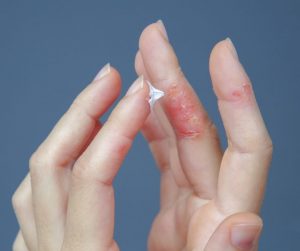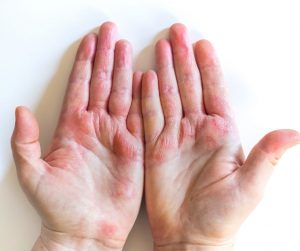Dyshidrotic eczema, also known as pompholyx eczema, is a skin condition that causes small blisters on the hands and feet. While the cause of dyshidrotic eczema is unknown, it is thought to be related to allergies or an autoimmune disorder. Symptoms include intense itching, burning, and stinging sensations.
Dyshidrotic eczema can be treated with topical creams and ointments, but oral medications or light therapy may be necessary in severe cases. With proper care, dyshidrotic eczema can be managed effectively and does not usually cause long-term problems.
Dyshidrotic eczema can be challenging to treat, but there are several things you can do to help manage the symptoms. This article will discuss the causes and symptoms of dyshidrotic eczema and some treatment options. We will also provide tips for managing the condition in daily life. Keep reading to learn more about dyshidrotic eczema and small bumps on hands.
Causes of dyshidrotic eczema small bumps on hands and toes
The exact cause remains a mystery and unknown, but several possible triggers exist. It was previously thought to be caused by an issue with the sweat ducts, but that theory has been debunked. However, it is now believed that people with dyshidrotic eczema are hypersensitive to certain triggers, such as metal, specific ingredients in personal care products ( like soap or moisturizer), and medication (like birth control or aspirin) and smoking (tobacco). In addition, stress and weather changes can also lead to flare-ups of dyshidrotic eczema.
What triggers Dyshidrosis? Here are a few common causes of dyshidrotic eczema small bumps on hands, feet and toes.
- Stress
- Seasonal allergies like hay fever, asthma and allergic rhinitis.
- Weak immunity
- Sweaty or wet hands and feet
- Metals like nickel, cobalt, chromium salts, or jewellery can also cause this condition
- Weather changes like warm or humid air.
Symptoms Of Dyshidrotic Eczema
The patient’s skin may become red and swollen with tiny blisters. These itchy bumps are usually found on the palms of hands, sides or feet in severe cases but can also appear anywhere else if not treated quickly enough. Common symptoms include;
- Pain sensation on the palm, feet or sides of the finger where it will appear
- Blisters on the finger or whole hand.
- Swelling may also occur.

Diagnosis
There is no specific laboratory test that can diagnose this type of eczema. Still, your dermatologist will probably ask you about your blisters and see if there might be a pattern.
They might also want information on what kind of products or stresses had caused them in recent months and whether any metal exposure had happened at work or home during those times when the eczema was active (which can sometimes occur). If it seems like an allergy could play some role here – they may ask you to do an allergy test.
How To Treat Dyshidrotic eczema small bumps on hands
Dyshidrotic eczema small bumps on the hands can be frustrating and embarrassing. It causes the skin to become dry, cracked, and itchy and can lead to blisters.
Treatment for dyshidrotic eczema typically involves using topical steroids to reduce swelling and help get rid of the blisters. If a severe flare-up occurs, oral steroids may be necessary. In addition, antihistamines like loratadine, cetirizine etc., can help relieve the itch associated with dyshidrotic eczema.
For best results, treatment should be started at the first sign of a flare-up. If these medications don’t work, your doctor may prescribe other types of treatments; Here are some of the commonly used treatments for Dyshidrotic eczema.

Light therapy, also called phototherapy, is a treatment that uses ultraviolet (UV) light to improve skin conditions. Light therapy is used to treat various skin conditions, including dyshidrotic eczema, psoriasis, and vitiligo. The exact mechanism by which light therapy improves these conditions is not fully understood.
Botulinum toxin is an excellent option if you want to get rid of Dyshidrotic eczema. It’s also an excellent choice for people who constantly deal with hot, sweaty feet or hands because these shots will stop your hands and feet from sweating, which can trigger blisters that cause itchy skin conditions like Dyshidrotic eczema, small bumps on the hands.
Another way to manage Dyshidrotic eczema is by using medicines that slow your immune system. Tacrolimus ointment or pimecrolimus cream can calm the swelling and irritation caused by an overactive immune reaction in those with dyshidrotic eczema. Talk to your doctor before using this or any other medicines.
If your condition is more severe, your doctor may also prescribe other medications like antifungal medications, steroid tablets or creams, and Immunosuppressants can also be used in extreme cases where there is no response from topical remedies.
These are some treatments, but if you want to control it at home, do these precautionary measures to prevent or stop Dyshidrotic eczema.
Hand washing is one of the most important things to do every day, and it can help prevent you from getting sick, especially if your hands are prone to allergies or infections. Be sure not to use too hot or scented water because it could burn your delicate skin.
Practice good hygiene by taking out the garbage and doing other household chores with gloves.
It’s always good to put some moisturizer on your hands and feet when showering or washing. You can seal it in water by applying it while still wet, which will help keep you from getting dry patches of skin. If that isn’t enough for protection, though, I recommend using one with dimethicone because this ingredient helps protect against sun damage.
Your dermatologist may recommend a low cobalt/nickel diet for you to follow if they suspect that an allergy causes your dyshidrotic eczema to nickel or copper.
You can also use a humidifier in your home. A humidifier can help prevent your skin from becoming too dry by adding moisture to the air.
If you suffer from eczema, you may find that allergies can trigger flare-ups. To help prevent this, it is best to avoid things that set off your allergies.
Frequently Asked Questions (FAQs)
What are the tiny bubbles on my hands?
Have you ever had an itchy, red rash like tiny bubbles that feel like the little hairs on your arms are standing up? The tinny bubbles on your hand are a sign of Dyshidrosis. It’s an itchy skin condition that causes tiny blisters and dry, crackly patches to form over the fingers or feet.
What is the fastest way to get rid of dyshidrotic eczema?
There is no approved treatment for this condition, but your dermatologist may prescribe some topical or oral steroids, anti-allergic medicines like loratadine etc., along with remedies. If you want to know more about the best treatment for dyshidrotic eczema, you can read our treatment section.
Is dyshidrotic eczema an autoimmune disorder?
It is not fully known, and there is no concrete evidence supporting this type of condition is of autoimmune origin. It is not clear what causes dyshidrotic eczema, but it is thought to be related to an overactive immune response. Few studies have looked at the immune response in people with dyshidrotic eczema, so much remains unknown about this condition.
How do you prevent Dyshidrosis?
Some of the common ways to prevent Dyshidrosis are washing your hands regularly, using humidifiers, avoiding direct contact with allergens, using moisturizers and over the counter anti-allergic medicines.
Does Vaseline help dyshidrotic eczema?
Vaseline is a Petroleum jelly that is an effective treatment for eczema flare-ups, and it is well tolerated and works well for sensitive skin. Although it is not an approved treatment, it is safe to use and can reduce irritation, redness, and discomfort.
Bottom Line—Dyshidrotic eczema Small Bumps On Hands & Feets
Flare-ups of dyshidrotic eczema small bumps on hands and feet, typically clear up within a few weeks without any long-term problems.
If you can avoid scratching the affected skin, it may not leave any noticeable marks or scars. However, if you rub the area, you could experience more discomfort, and your outbreak may take longer to heal.
Additionally, you could develop a bacterial infection due to scratching and breaking your blisters. Although your outbreak of dyshidrotic eczema may heal completely, it can also recur. Working with your dermatologist to develop a personalized treatment plan is the best way to manage this condition.
Related Articles
